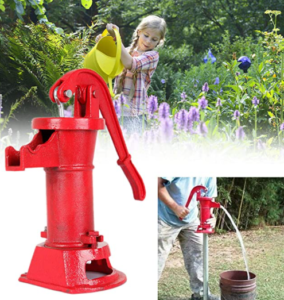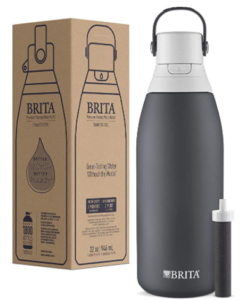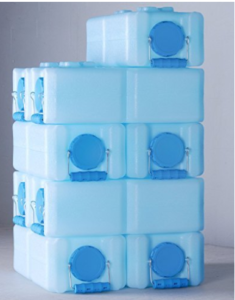Indoor water storage is a vital part of your home preparation planning.
Of course, you know that water is essential to life. But somehow, in all the prepping guides shared here on DIY Home & Garden recently, we overlooked this topic! We’ve discussed everything from plants you can grow indoors during the winter to canning long-term food for storage. But without water to nourish those seeds or wash your hands and prepare your food, you have nothing!
My prepper friends have lively debates on this subject matter and insist that without water storage there’s no need to bother with the rest of their preparations. We literally die without it. Point made.
So we will take a step backward today and talk about indoor water storage at greater length, rounding up our personal knowledge and the research we found online about this topic.
Table of contents
- 7 Best Reasons Why You Need Indoor Water Storage Systems in Place
- 1 – Staying hydrated during an emergency
- 2 – Indoor water storage means healthful food preparation
- 3 – Handwashing
- 4 – Indoor water storage can mean flushing the toilets
- 5 – Bathing and personal care
- 6 – Indoor water storage and your indoor plants
- 7 – Indoor water storage enables you to take care of your pets
- Are You on a Public Water System?
- Do You Have a Residential Well?
- The Weight of Water and Indoor Water Storage Planning
- 5 Types of Indoor Water Storage Containers
- Indoor Water Storage: Safety Tips for Fresh, Healthy Water
- Final Thoughts on Indoor Water Storage for Your Home Emergency Preparation Supplies
7 Best Reasons Why You Need Indoor Water Storage Systems in Place
Consider these primary reasons why you should invest in portable water storage inside your home.

1 – Staying hydrated during an emergency
During an extended emergency or power outage, you will expend more energy performing manual tasks. That also means you need to stay hydrated and not ration water because you fear you’ll run out imminently.
2 – Indoor water storage means healthful food preparation
If you store MREs or dry, powder mixes or kits for quick meals you can “bake” on your grill or an alternate heat source, you must mix them with water.
3 – Handwashing
The last thing you need during an emergency is to get sick. Handwashing is always essential to good health. Indeed, a catastrophe is no exception. From meal prepping to preventing the spread of contamination or viruses, you need a reliable method.
4 – Indoor water storage can mean flushing the toilets
Keeping a full water bladder in a bathroom gives you a way to flush the toilets, as long as you have a gravity-fed system. But that’s an entirely different discussion for a separate blog post!
5 – Bathing and personal care
Despite a loss of power and access to water, you have personal hygiene needs to meet. From the ability to clean yourself or brush your teeth (with treated or boiled water), you can keep yourself somewhat fresh.
6 – Indoor water storage and your indoor plants
If you grow indoor plants in a greenhouse or on a windowsill, you can keep them moist if this outage becomes ongoing. Note: the water storage containers in this article address your household’s indoor needs. However, we plan to address outdoor water storage in a separate post soon.
7 – Indoor water storage enables you to take care of your pets
Just like people, your dogs, cats, birds, and all other pets need to stay hydrated. A catastrophe is no exception. You can continue to give your critters the life-giving source they need if you keep a water tank at the ready.
Are You on a Public Water System?
Many people think that a public water system protects them from going without water. For a short-term power outage, you should be fine.
Here’s how public water systems deliver water to your household. The community water authorities pump water into tall towers, which send the water flow to the connected homes using gravity. However, it takes power to get the water to that tower. So once a tower empties, you will not have water until they restore power to the pump that helps them fill the storage towers.
It’s also worth noting that community water purification systems might not work correctly. Thus, you should boil or sterilize water, even if your taps still run. That statement is not guesswork; it comes straight from CDC guidance.
I can attest to this. We have “county water” inside the house for personal use.
In 2016, Hurricane Matthew came through our area, bringing extensive flooding that destroyed much of our county seat. Emergency managers had to cut power to large areas due to electrical fires throughout large swaths of our region. For a little while after the storms, we had water. But after the water stored in the large community water towers ran dry, the county could not pump more water to refill them for several hours. Of course, that left us without water. Fortunately, we had bottled water and a filled bathtub to get us through. But that was a lesson we learned well.
Do You Have a Residential Well?
Before you start sinking lots of your cash into indoor water storage containers… Are you on a residential well? The United States Environmental Protection Agency (EPA) reports that over 13 million households still use well water.
In this case, you have lots of water. The challenge–the pump will not work in a power outage. If you have a well, you should focus your spending on an alternate pump on pulling the well water out of the ground and delivering it to your home.
Besides the county water inside my home, we also have a residential well–it was apparently original to the house. We use the well water for gardening, outdoor chores, and car washing only. But in a power outage, this does not work, as the pump is electric only. Thus, we started our own research on how to “power” the pump as part of our home prepping.
You will need a basic understanding of disassembling your electric-powered pump and replacing it with one that runs with manual or solar power. A manual pump is relatively inexpensive compared to the solar option. But either one will bring you water in an emergency. These are essential for home prepping if you have a well.


For the rest of this article, we will assume that you have a community-supplied source, and you need to find a way of storing water for your home prepping. Thus, you need off grid indoor water storage basics, including all the details.
The Weight of Water and Indoor Water Storage Planning
A vital consideration you should not overlook when deciding on the best indoor water storage containers for your lifestyle is their weight. In fact, it has a rather hefty weight of 8.33 pounds per gallon when stored at 70°F. As the temperature increases, the weight gradually reduces, with a weight of 200°F when it reaches a boil. Interesting fact. But you will store your water at room temperature, so plan on the 8.33 pounds.
The weighty nature means you must exercise caution when deciding on the size of a water bladder and where to store it. For example, you don’t want to place this extremely hefty liquid over deteriorated floor joists in an older home. Instead, find a solid location, like a concrete basement floor or another sturdy spot.
5 Types of Indoor Water Storage Containers
Let’s look at five typical ways of storing water for your home prepping supplies, touching on the pros and cons of each one.
For potable drinking water, these containers must have the following:
- Have a tight lid or cap to keep out bacteria or pests.
- Be durable and unbreakable.
- Food-grade quality, never used for chemical storage.
The suggestions below all meet (or exceed) these basic standards.
1 – Bottled water for humans and pets to drink
The most basic way to start storing water is by investing in bottled water. When you do this, note the use by date on the plastic overwrap with a permanent marker. Rotate and use this, replenishing your stockpile as necessary.
In addition to bottled water, you might consider purchasing a reusable water bottle with a built-in filtration component. While the one-time purchase of this bottle is higher than plastic disposable, you may save money over the long term. Remember that your city water might be flowing, but the filtration might not work – this reusable bottle addresses that need for short-term water use.
Besides built-in filter bottles, you may consider survival straws. The straws let you drink from your water tank, as it contains a filter to remove harmful bacteria. These options are ideal for someone with limited space to store preps.

- Note: If you feel concerned about plastic waste, consider the new boxed water alternatives. Boxed water eases the mind of those concerned about BPA or environmental concerns, albeit a higher investment.
2 – Water jugs
Water jugs come in an enormous range of sizes, usually sized from half-gallon all the way up to six-gallons (although some are larger). Most people choose a smaller size to easily lift and pour to dispense it without the heavier weights of the larger units. You can find a vast range of sizes, colors, and shapes to suit your home prepping needs.
Water jugs are affordable (you can look at a price here) and weigh next-to-nothing when you’re not using them.
The downside to water jugs is the large amount of real estate they consume. Most are not sized for stacking (but some are if you want to spend the extra money).
You might also consider large hanging large water bladders (like backpackers and hikers use) if you want to hang them up for storage on a rack.
- Hack for saving money: Besides purchasing water jugs, you can also save and rinse your two-liter soda or seltzer bottles or empty milk jugs with hot water. Add a few drops of bleach to disinfect, rinse again, and fill when you need are ready for them.
3 – Water bricks for indoor water storage
Water bricks are a stackable, small, reusable option for off grid indoor water storage.
The typical size is 3.5 gallons per brick, and they measure about 25″ long x 18.6″ wide and deep. With these water bricks, you can stash supplies under a bed, in a small closet, or anywhere else you have a nook or cranny. They will stack from the floor up to the ceiling if you need them to fit in a tight but tall spot. If you must evacuate, they are light enough even for the kids to help you grab and go.
On the other hand, water bricks typically cost more per ounce to store. But for the smaller size, many people find them to be worth it.

4 – Water barrels for indoor water storage
Food-grade blue plastic water barrels or drums are good if you have a concrete slab home or a basement to keep them. In fact, they hold lots of water per unit–30 to 45 gallons. If one would spring a leak, this could do a lot of water damage–just a consideration.
If you have a large family, consume a lot of water each day, or do some serious home prepping, they can be a good solution for you. You can even purchase water barrel storage racks to store them on their sides.
However, they require careful maintenance to keep fresh and are challenging to use when you need access in an emergency.
5 – Water bobs
A water bob is a semi-rigid liner that sets down inside your bathtub for storing water. This pick is my personal choice, and I have one in my hurricane supplies. Should a hurricane be forecast for my part of North Carolina, I take it out of storage and fill it about halfway. This amount gives me enough water for washing and toilet flushing. Additionally, it keeps me out of my long-term stash until necessary; so far, the power comes back on before I need to access the jugs.
It is convenient and folds flat when not in use. However, you must be confident that your bathroom flooring will hold its weight. In my case, the floor is reinforced for the original, heavy cast-iron bathtub.
Another advantage is that you will not worry about it leaking–it is in the bathtub!
This method is not portable like jugs or bricks, on the downside. But we plan to shelter-in-place, no bug-out, no matter what.
Indoor Water Storage: Safety Tips for Fresh, Healthy Water
Now that you know the types of indoor water storage containers let’s talk about safety.
According to the CDC guidelines for water storage guide, follow this method:
1 – Clean the indoor water storage container before you use it.
- Step One: Wash the storage container and rinse it well.
- Step Two: Use bleach containing 5% to 9% sodium hypochlorite to sanitize the container. Dilute one teaspoon of bleach in one quart of water. Cover and shake it well enough for the liquid to touch each surface of the container’s interior. Wait thirty seconds, and pour out the bleach solution.
- Step Three: Allow the vessel to air-dry.
- Step Four: Fill the container with clean water and cap it tightly with the lid.
2 – Storing water safely
- CDC also states that when you use the prescribed method, the water stays fresh for six months, as long as you do not uncap it. Label the container with the date you stored it, and be sure to rotate and refresh it in six months.
- How much water should you store? Emergency management experts estimate that each person in your household needs one gallon of water per person per day. Of course, you should plan extra if you have pets.
- Find a dark, cooler location for long-term storage. Heat and sunlight can degrade the quality in a relatively quick time. Conversely, freezing can cause the containers to crack and lead to flooding. Thus, storing water at a temperature of 50°F to 70°F is optimal.
- Don’t store emergency water near chemicals, pesticides, or gasoline.
- Wash your hands or apply hand sanitizer before handling your drinking water supply to avoid introducing contaminants.
Final Thoughts on Indoor Water Storage for Your Home Emergency Preparation Supplies
Living in a coastal area of North Carolina, emergency preparation supplies are at the forefront of our minds, especially during the volatile hurricane season. However, the very nature of emergencies is that they are unpredictable. And the most basic need of all to sustain life is, of course, water. Even if you do no other home prepping, storing water is one aspect every homeowner should at least consider.
Do you have thoughts or expertise on indoor water storage? Please feel free to share them with us on social media. We love hearing your feedback and ideas. Until the next time, have a happy DIY day.

